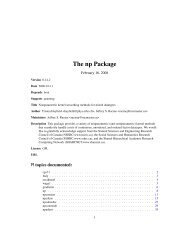The mvpart Package - NexTag Supports Open Source Initiatives
The mvpart Package - NexTag Supports Open Source Initiatives
The mvpart Package - NexTag Supports Open Source Initiatives
Create successful ePaper yourself
Turn your PDF publications into a flip-book with our unique Google optimized e-Paper software.
20 predict.rpart<br />
Details<br />
This function is a method for the generic function predict for class rpart. It can be invoked by<br />
calling predict for an object of the appropriate class, or directly by calling predict.rpart<br />
regardless of the class of the object.<br />
Value<br />
A new object is obtained by dropping newdata down the object. For factor predictors, if an<br />
observation contains a level not used to grow the tree, it is left at the deepest possible node and<br />
frame$yval at the node is the prediction.<br />
If type="vector":<br />
vector of predicted responses. For regression trees this is the mean response at the node, for Poisson<br />
trees it is the estimated response rate, and for classification trees it is the predicted class.<br />
If type="prob":<br />
(for a classification tree) a matrix of class probabilities.<br />
If type="matrix":<br />
a matrix of the full responses (frame$yval2 if this exists, otherwise frame$yval). For regression<br />
trees, this is the mean response, for Poisson trees it is the response rate and the number<br />
of events at that node in the fitted tree, and for classification trees it is the concatonation of the<br />
predicted class, the class counts at that node in the fitted tree, and the class probabilities.<br />
If type="class":<br />
(for a classification tree) a factor of classifications based on the responses.<br />
See Also<br />
predict, rpart.object<br />
Examples<br />
data(car.test.frame)<br />
z.auto

















